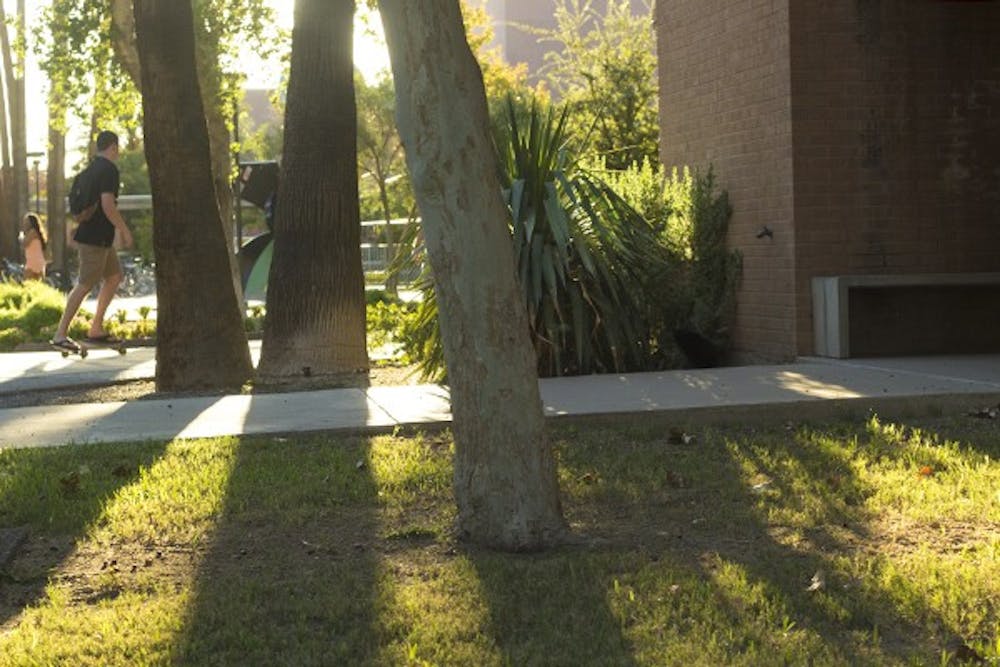 A black cat hides from students behind a bush by Wilson Hall on Tempe campus. (Photo by Alexis Macklin)
A black cat hides from students behind a bush by Wilson Hall on Tempe campus. (Photo by Alexis Macklin)
Invisible during the day and usually leery of people, campus cats hide in the bushes until they decide to come out at night. Even such short appearances make some uncomfortable.
The Tempe campus is a home for about 50 homeless cats — feral and stray. Mildcats is the only ASU organization that has been taking care of those cats since 2002 by feeding, monitoring health and executing a Trap-Neuter-Return program, although the volunteers are not always welcome to cat sites.
One of the largest cat colonies lives on the territory of Adelphi Commons, making some residents upset.
Journalism senior Jazzy Garcia, a resident at Adelphi Commons I, said a lot of residents are not happy about the situations. She wants the cats gone and even wanted to call housing management, she said.
“The (cats) are gross,” she said. “They hiss at us, and they’re awful. They are everywhere.”
Communication senior Katie Meyer, who lives in Adelphi Commons I, said she has worked with ASU over the summer to help with the cat situation. Although a lot of kittens were taken out, the problem hasn’t been solved. Some people feed the cats with chicken bones and they end up all over Adelphi, she said.
“We encourage people not to feed them or give them water, but I feel like nobody’s really put an effort into trying to get them to go away,” she said. “Some people do (feed the cats), I do not though. I think they are gross.”
Carmen Febus, student adviser for the club and a research technician for ASU’s Nutrition Department, said she was occasionally “harassed” by the residents of Adelphi Commons I, when trying to take care of the cats.
“It’d be nice to have their support," she said. “It’s really stressful when you get there and all the girls are giving you a hard time.”
Adelphi Commons administration asked Mildcats to leave the site two or three years ago, when there were around ten cats on their territory. Without the proper care, the situation spiraled out of control this spring when the cat population skyrocketed to around 30 cats and many kittens, causing Adelphi residents to contact Mildcats again.
After taking out 36 kittens over the summer, Febus said it is a “prime example” of what happens without the Trap-Neuter-Return program.
 Three feral cats eat food provided by Mildcats volunteers outside of Wilson Hall. (Photo by Alexis Macklin)
Three feral cats eat food provided by Mildcats volunteers outside of Wilson Hall. (Photo by Alexis Macklin)
Trap, Neuter, Return
TNR is advocated by Maricopa County Animal Care and Control and Humane Society of the U.S. as an effective way to restrain the growth of cat populations and avoid euthanasia. Years of practice have proved the number of cats taken to the pound and put down has decreased, Febus said.
After being trapped, feral cats are neutered and then returned to their original sites, because they are not socialized to humans and not adoptable.
Domesticated stray cats often appear on campus as a result of students’ irresponsible behavior, such as moving and leaving animals behind. However, abandoned and stray domesticated cats get a second chance of finding a loving family. All cats are vaccinated for rabies and distemper to create a safe environment for students.
“There’re a lot of good things about TNR,” Febus said. “Obviously killing cats hasn’t been a solution, because people have been killing cats in the U.S. for years, we’re talking about decades. So obviously that’s not helping.”
Thanks to the program, Mildcats managed to reduce the Tempe cat population from 200 to around 50 throughout the years. Future plans include installing cameras on several sites to keep track of the numbers and displaying signs “monitored community” to assure the cats are taken care of.
Students and residents may not be familiar with the program and therefore arrive at wrong conclusions, Febus said.
“I think a lot of people don’t realize we do TNR,” she said. “They think we just go there and feed the cats. So, I understand, but people don’t talk to you rationally; they get so nasty.”
Curtailing Adelphi's cat colony
Mildcats feeds the cat populations it monitors every night, and it’s not unusual to hear complaints from the residents of Adelphi, which has a large cat colony, trying to urge the organization to move the cats out.
The organization took proactive steps by sterilizing 12 cats and trying to trap the others at Adelphi. However, it hasn’t been an easy task, Febus said. Some residents feed the cats, making it harder for the organization to trap.
Mildcats have been trying to move the cats further away from Adelphi, though relocating cats from their established territories may be ineffective. Oftentimes, uprooted cats will wander away from their relocation sites and new cats move into a vacated territory.
Febus said they are now on board with Adelphi Commons administration, but it’s going to take a lot of time and money to get the situation back under control.
“Fortunately, I think more students are for the cats than are against the cats, but the ones that are against are really loud,” Febus said.
Speech and hearing science sophomore and Adelphi Commons I resident Grace Buchanan said even though there’re a lot of cats living next to her sorority, they haven’t bothered anyone much.
“They are actually pretty good; they are hiding in the bushes a lot,” Buchanan said. “Here and there they’ll run across, usually they are pretty hidden. They are actually really nice.”
 Mildcats volunteer Erin Luntey feed cats outside of the Wilson Hall on Tempe campus. (Photo by Alexis Macklin)
Mildcats volunteer Erin Luntey feed cats outside of the Wilson Hall on Tempe campus. (Photo by Alexis Macklin)
University support
ASU’s Facilities Management supports the TNR program and collaborates with Mildcats. The department concluded an agreement with Mildcats in 2003, in which ASU authorizes Mildcats in coordination with ASU’s Facilities Management office to be the “first responder” in handling all homeless cats on ASU campuses.
“It recognizes that, due to both human nature and animal behavior, a certain population of cats is always present in large, human-dominated, “resource-rich” landscapes such as college campuses, and the permanent removal of all cats from such landscapes is neither physically nor economically feasible,” the agreement states.
ASU Facilities Management Administrator Ellen Newell said the University has been very supportive of Mildcats and its methods, and had staff members as volunteers.
“The University supports the idea very much,” she said. “By spaying and neutering they control the territory which helps keep other cats out, so the population doesn’t keep growing. ... People dump cats, then we have an issue. We are very supportive of the groups.”
 Mildcats volunteer Erin Luntey feeds a cat outside of Wilson Hall on Tempe campus. (Photo by Alexis Macklin)
Mildcats volunteer Erin Luntey feeds a cat outside of Wilson Hall on Tempe campus. (Photo by Alexis Macklin)
Growing the program
Mathematics junior Krystal Yeager is the president of a Mildcats student chapter. After she found out last fall that all student members had graduated, she decided to take the lead.
Yeager hopes to attract more students to the organization who will give a hand at taking care of the fluffy campus inhabitants. Although the feral cats are hard to approach and the immediate results might be hard to observe, the bigger goal is fulfilling, she said.
“You feel like you’re not doing that much when you’re just trapping them and getting them fixed, but you’re helping other cats to get adopted eventually, because there’s more space for them to live in a shelter to have that chance,” she said. “And it prevents kittens from being born and having to be put down months later. So it does help; it’s just hard to see how it helps when you’re out there doing it, but it does.”
Mildcats is holding their first student meeting Aug. 29 in PSA 111 at 6:30 p.m. to welcome everyone who is interested in helping cats and volunteer with animals on and off campus.
One of the most important missions of the club is to educate students about the responsibilities that come with getting a pet, Yeager said.
“Our county is the second highest for euthanasia in the U.S. Maricopa County kills a ton of animals,” Yeager said. “We have to stop the problem ... and it starts with us being responsible.”
Reach the reporter at kmaryaso@asu.edu or follow on Twitter @KseniaMaryasova




